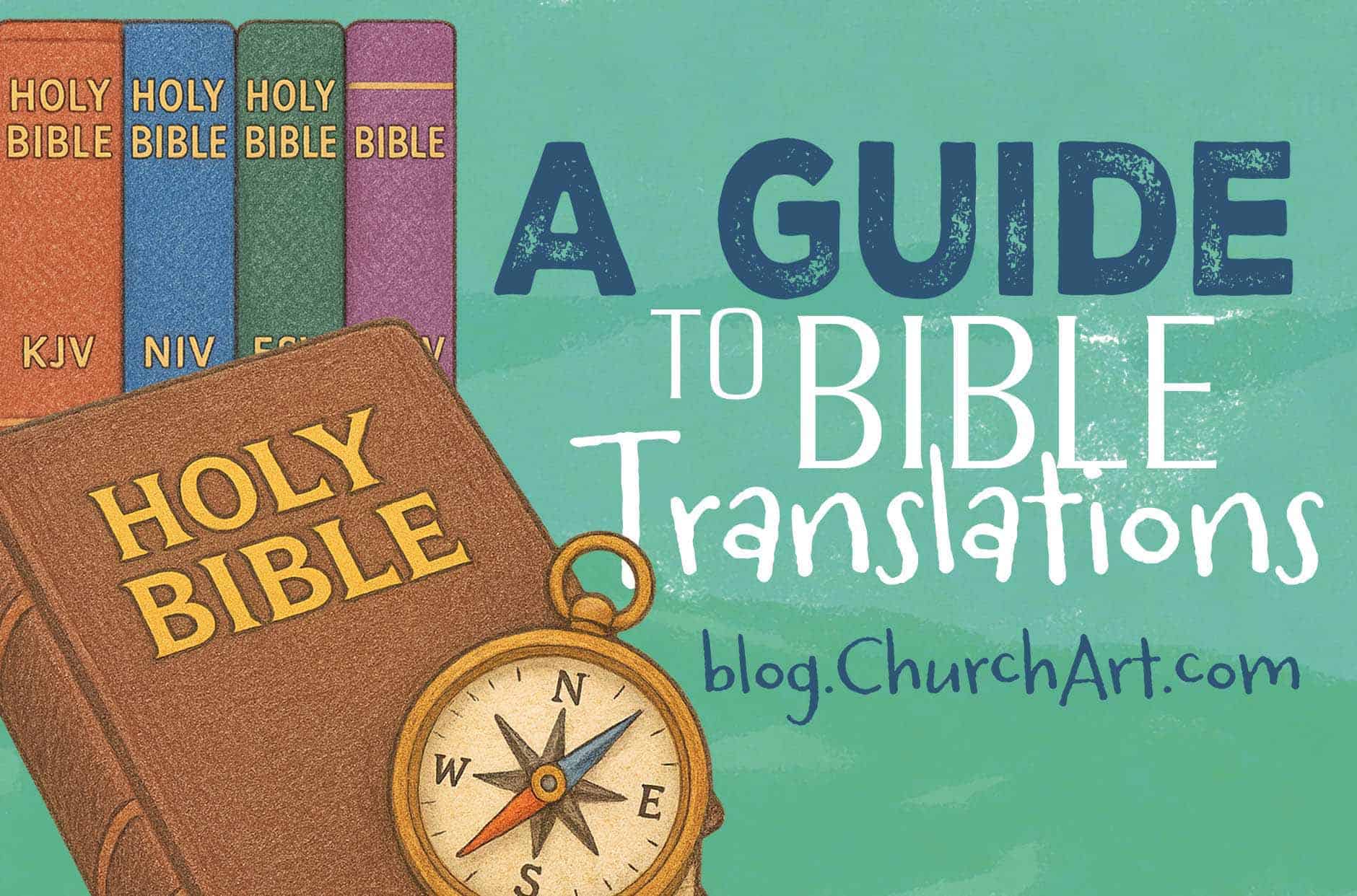
A Guide to Bible Translations: The Best Bible Translations for Church Bulletins, Newsletters, and Worship Slides
As an editor who prepares church bulletins, newsletters, and worship slides, you may wonder which Bible version or translation to use. With so many options available, the decision can feel overwhelming. Add in paraphrases and newer offerings, and the choice seems even more daunting.
The good news about the Good News? You don’t have to figure out Bible translations alone. A careful review of different translations will improve your church communications and anchor congregants in God’s Word.
Keep reading for an overview—and learn why the choice of translation matters. Also find tips for working with church leadership to most effectively share the Holy Bible with church members.
An Overview of Bible Translations
Two general categories of Bible translations include word-for-word and thought-for-thought:
- Word-for-word translations try to remain as close as possible to the original texts (Hebrew for the Old Testament, Greek and Aramaic for the New Testament). Examples of word-for-word translations include the King James Version (KJV), New King James Version (NKJV), New American Standard Bible (NASB), and English Standard Version (ESV). Because these versions preserve the structure and vocabulary of the original biblical languages, modern readers sometimes find them formal or difficult to understand.
- Thought-for-thought translations, or dynamic equivalence translations, try to provide clear, readable text in today’s English. But sometimes that requires rephrasing of the original Old Testament and New Testament text. Examples of thought-for-thought translations include the New International Version (NIV), New Revised Standard Version Updated Edition (NRSVUE), and New Living Translation (NLT). These options make Scripture accessible and understandable without overly complex sentence structures.

Also note that translations differ from paraphrases. A paraphrase, such as The Message or The Living Bible, isn’t a direct translation from the original languages. Instead, it’s a restatement of the meaning in fresh wording. Because paraphrases prioritize expression over precision, they are powerful for devotional reading and Bible journaling.
Here’s a quick snapshot of classic and modern translation options for churches:
- KJV (King James Version): This 1611 classic (which is in the public domain) contains beloved Hebrew poetry. But modern readers may stumble over some archaic wording.
- NKJV (New King James Version): This update of the KJV uses modern wording while preserving a traditional tone.
- NASB (New American Standard Bible): Known for accuracy and precision, this is excellent for Bible study.
- ESV (English Standard Version): A balance of readability and accuracy makes this Bible version a favorite for preaching.
- NIV (New International Version): This popular version offers clear wording for a broad audience.
- NRSVUE (New Revised Standard Version Updated Edition): With its inclusive language, this version is popular in academic and mainline church settings.
Each Bible translation has strengths, and none is “wrong.” Preference often varies by church and denomination, whether traditional Roman Catholic or contemporary evangelical.
The key is determining which fits best for your church’s leaders and members. Many churches use a mix of Bible versions and biblical literature, depending on the audience and setting.
Learn Why Translation Choice Matters in Church Communications
When you’re assembling bulletins or PowerPoint slides for a worship experience, you might wonder if the Bible translation really matters. The short answer? Yes! Consistency across church materials builds trust and familiarity with Scripture. For worshipers, it’s confusing to see or hear the same verses worded in different ways. Using one translation consistently builds trust and reliability.
Translation choice also reflects your church’s tone and theology. The words you choose shape how people hear God’s Word, whether in a Bible study or in a social media post. A congregation with a strong traditional heritage may value the familiarity and reverence of the KJV or ESV. A church with an emphasis on outreach, evangelism, and accessibility may lean toward the NIV or NLT.
Clarity is also key. A verse that seems powerful in one translation may be difficult to follow in another. The right translation for your audience ensures that the message is accurate and understandable.
Talk with the Pastor or Leadership Team
The best way to handle decisions about Bible translations is to talk with a pastor or church leader. Many pastors preach from a specific version of the Bible, so they likely want bulletins and newsletters to match what congregants hear from the pulpit.

Also ask pastors to clarify when flexibility is okay. For example, the children’s ministry department might use a simpler Bible version. That way, God’s Word is accessible to younger Sunday school students.
Devotionals and newsletters might occasionally include a different translation or a paraphrase to give fresh insight. But for bulletins and worship slides, use the translation from pastor’s sermons. Consistency connects the written word with the spoken word, reducing distractions.
Choose the Right Translation for the Right Readers
Different audiences may call for different approaches. As mentioned, children’s programs benefit from clear, simple language. Bible versions such as the NLT, Contemporary English Version (CEV), or International Children’s Bible (ICB) help kids grasp Scripture’s meaning.
For worship slides, readability is a must. Congregations need to follow along quickly, often while singing. Translations like the NIV or ESV work well because they balance accuracy with flow.
Devotional content offers more room for variety. To help readers reflect on Scripture in new ways, you might include verses from a paraphrase like The Message or the Good News Bible (Today’s English Version) alongside a traditional translation.
Be Cautious with Online Sources

The internet makes it easy to copy and paste Scripture, but not all sources are reliable. Stick to trusted platforms such as BibleGateway.com or the YouVersion Bible app (see below). These services provide accurate text and let you select the translation you need.
A Bible verse quoted on blogs, memes, or social media might be inaccurate. So before publishing or sharing it, double-check the text against a reputable source.
For clarity, also include the translation abbreviation with each Scripture passage; for example, John 3:16 (NIV).
Respect Copyright of Bible Translations
Although God’s Word is free to all, modern translations are protected by copyright. As long as you give proper credit, publishers generally let churches use up to 500 verses in print or digital form without special permission.
When using Scripture quotations in church materials, add a credit line. For example: “Scripture quotations taken from the Holy Bible, New International Version®, NIV®. Copyright © 1973, 1978, 1984, 2011 by Biblica, Inc. Used by permission. All rights reserved worldwide.”
To confirm the proper wording, check each publisher’s website. Honoring copyright guidelines protects your church legally. Plus, it respects the labor that each faithful translator invested in producing accurate Bibles.
Access Helpful Bible Study Tools
The right tools make your job as a church administrator easier and more accurate. Trusted Bible resources include:
- BibleGateway.com: You can compare translations side by side, search keywords, and copy Bible verses with citations.
- YouVersion Bible App: A free mobile option provides dozens of translations plus easy sharing tools.
- Blue Letter Bible: This is excellent for digging into original-language meanings and cross-references.
- Logos Bible Software: Pastors and church leaders use this study tool to research and compare Scripture-based content.
These resources improve accuracy while saving time. With them, you know that the Bible verses you include in a church communication or church service are correct.
Use Bible Translations with Confidence
Don’t give in to Bible translation decision fatigue. With background information, insight from your pastor, and knowledge about your readers, you can choose the ideal version of God’s Word.
Remember: You don’t have to figure out Bible translations on your own! In addition to church leaders and study tools, the Holy Spirit guides you as you present Scripture to readers and listeners.
As a church editor, you don’t just compile announcements. You help the church community interact with the living Word of God. By handling Scripture with care, you strengthen the church’s mission while strengthening people’s faith in Jesus Christ.
ChurchArt Team
We love art, are passionate about helping churches create professional-looking communications and are a fun bunch of folks. With an in-tune creative director and a rock-solid team of artists, we will provide the art you’ll want to use, plus templates, puzzles and extras that make your job easier.



